American Expeditionary Force Worksheets
Do you want to save dozens of hours in time? Get your evenings and weekends back? Be able to teach about the American Expeditionary Force to your students?
Our worksheet bundle includes a fact file and printable worksheets and student activities. Perfect for both the classroom and homeschooling!
Resource Examples
Click any of the example images below to view a larger version.
Fact File
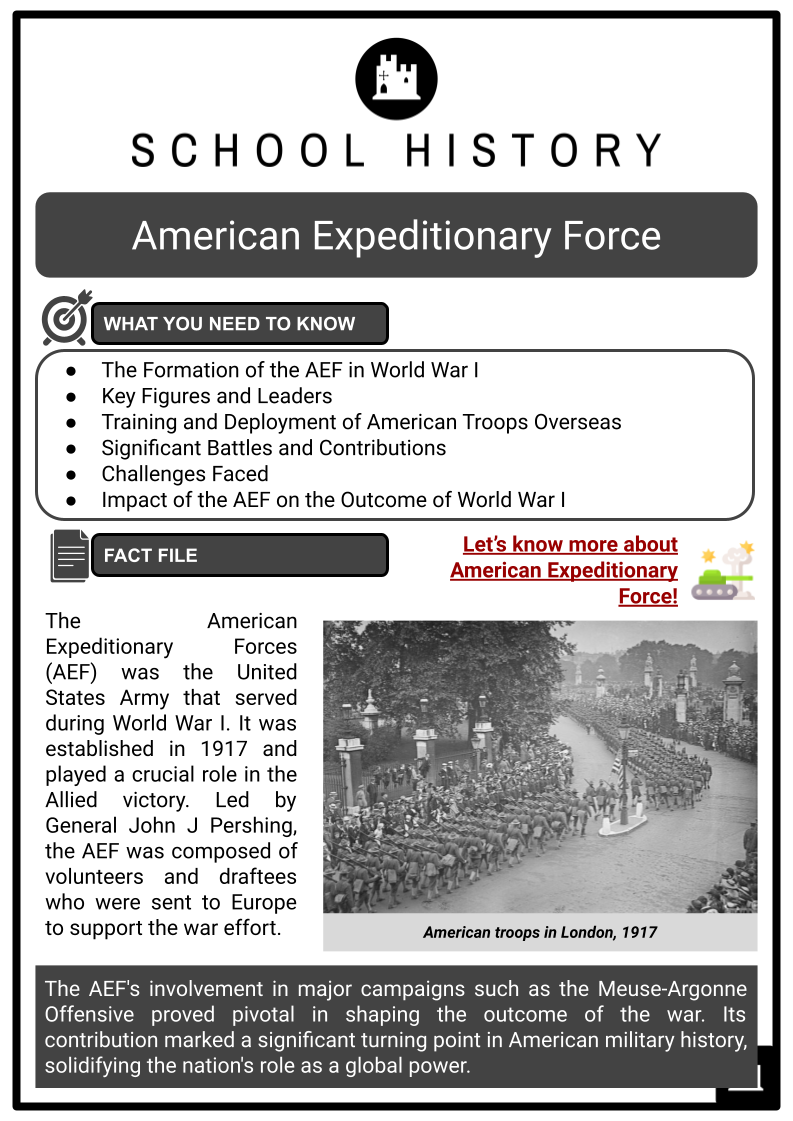
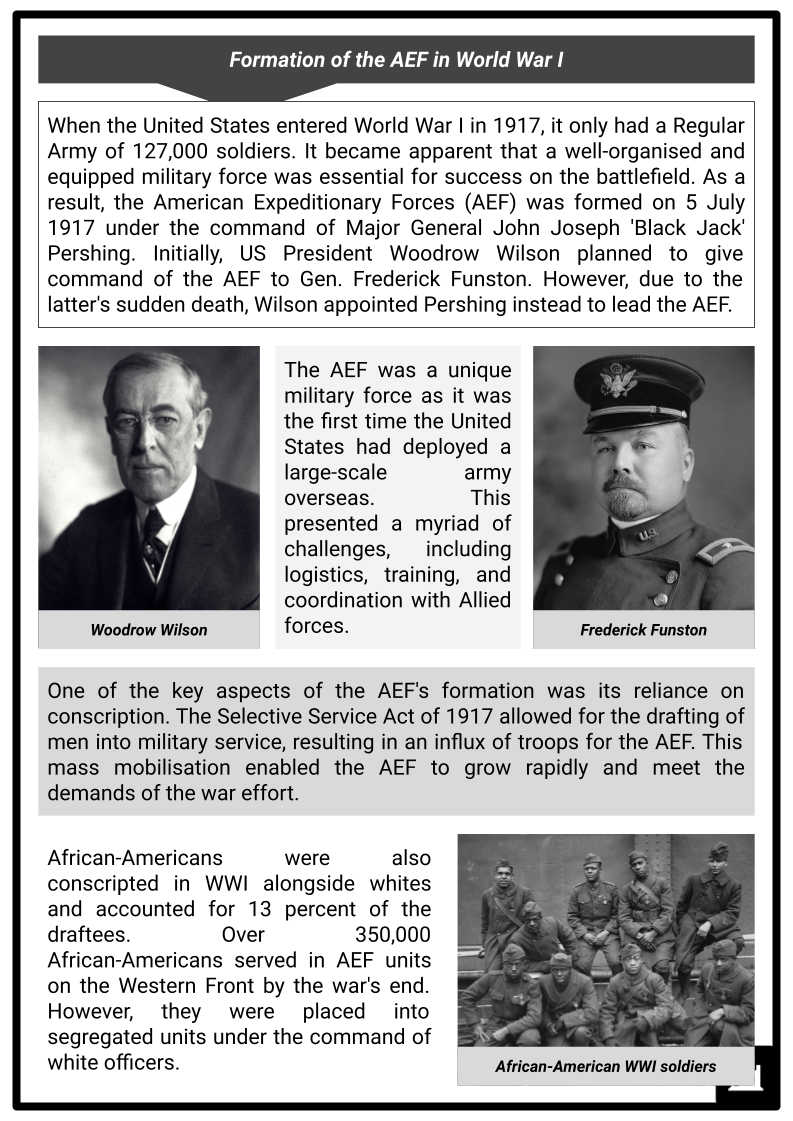
Student Activities
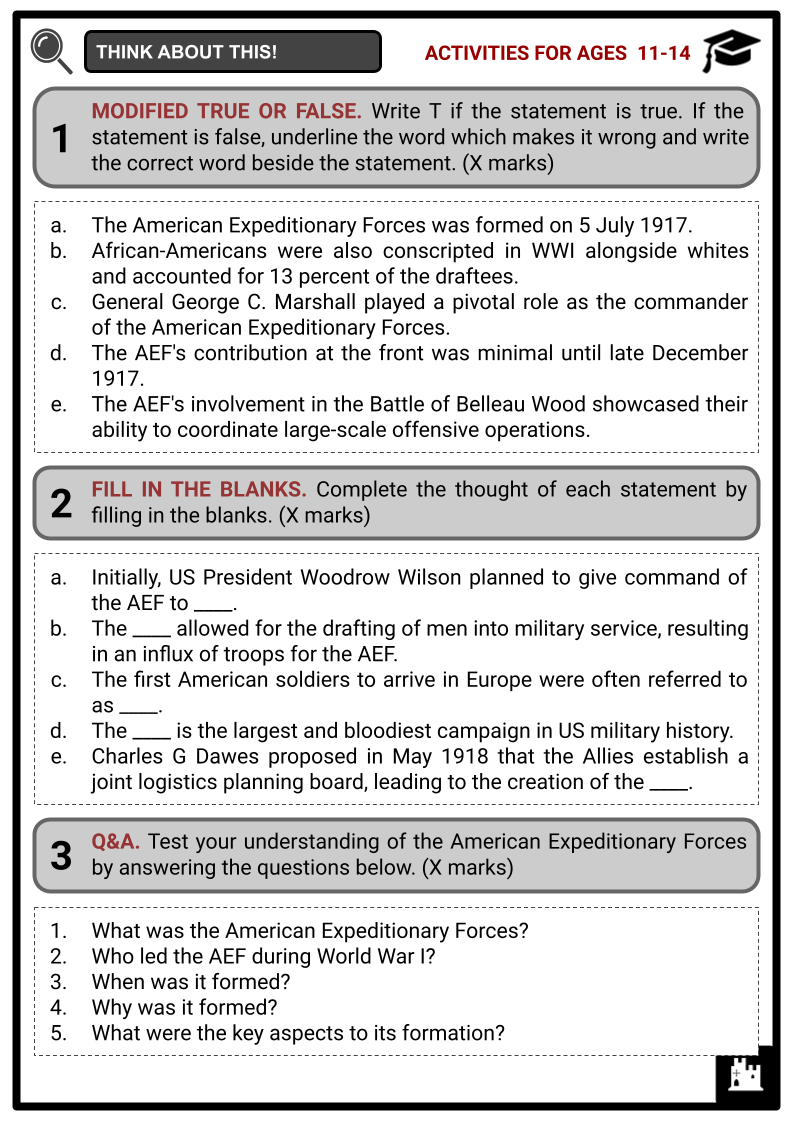
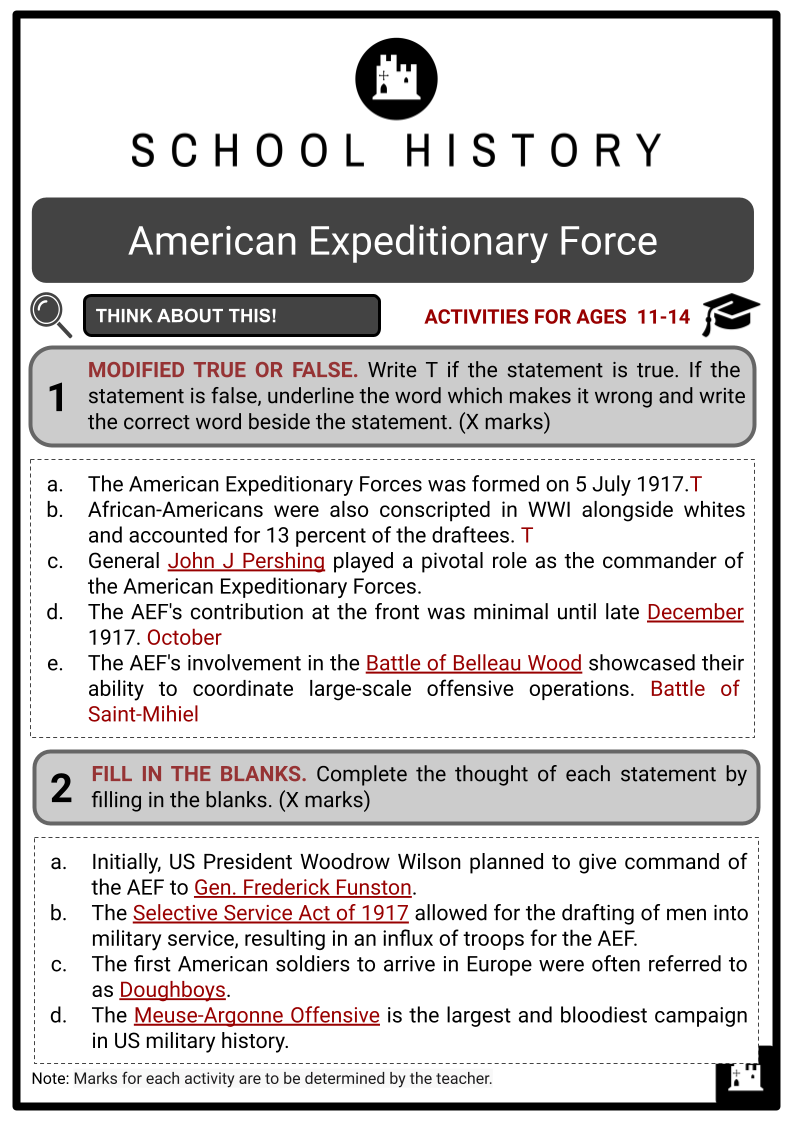
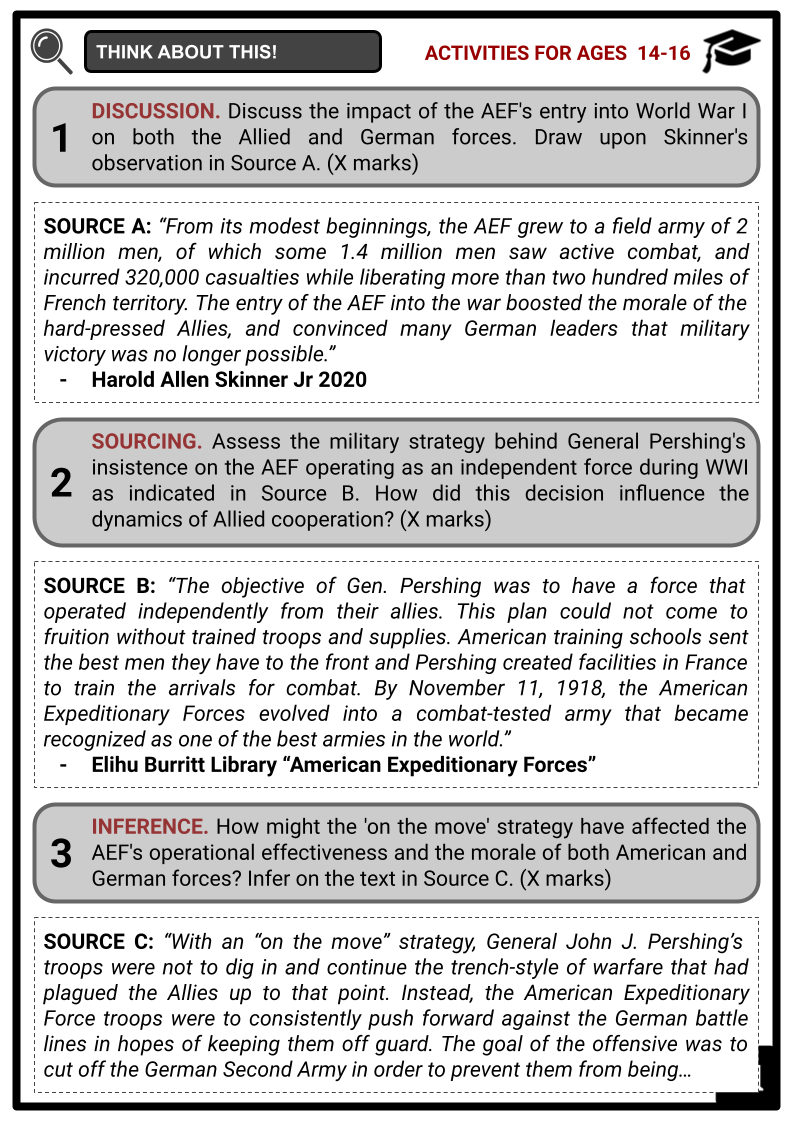
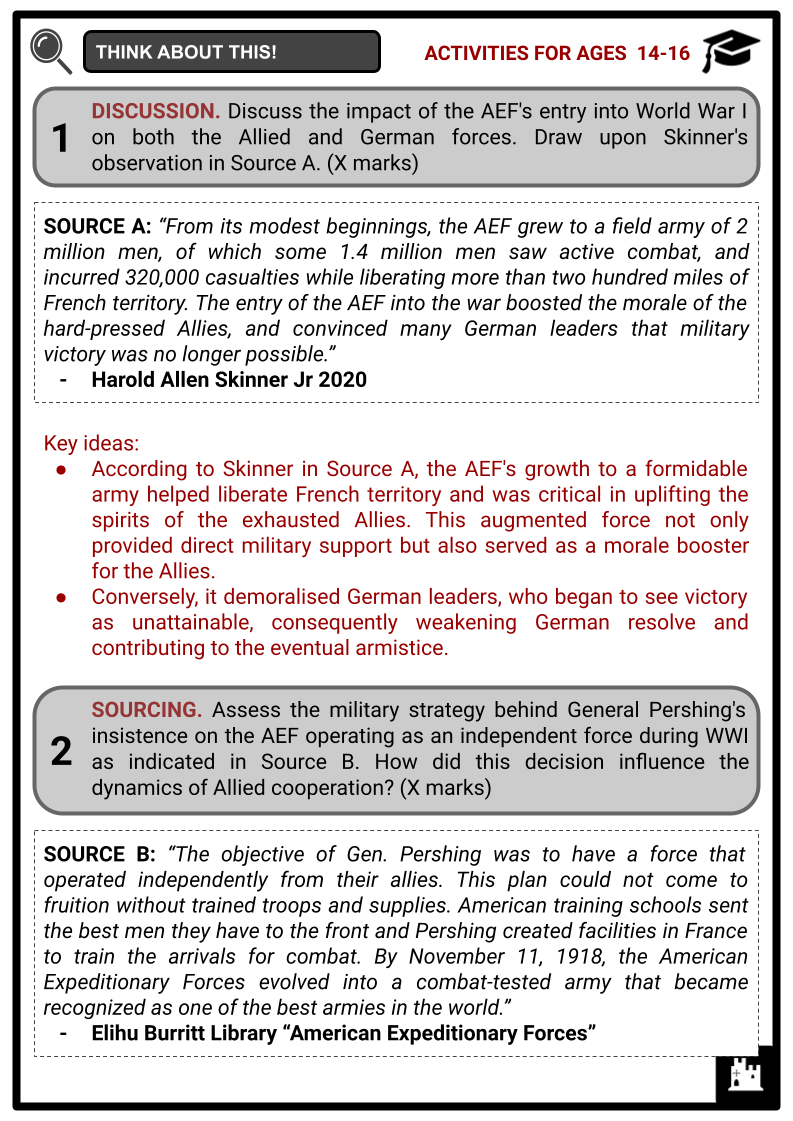
Summary
- The Formation of the AEF in World War I
- Key Figures and Leaders
- Training and Deployment of American Troops Overseas
- Significant Battles and Contributions
- Challenges Faced
- Impact of the AEF on the Outcome of World War I
Key Facts And Information
Let’s know more about the American Expeditionary Force!
The American Expeditionary Forces (AEF) was the United States Army that served during World War I. It was established in 1917 and played a crucial role in the Allied victory. Led by General John J Pershing, the AEF was composed of volunteers and draftees who were sent to Europe to support the war effort. The AEF's involvement in major campaigns such as the Meuse-Argonne Offensive proved pivotal in shaping the outcome of the war. Its contribution marked a significant turning point in American military history, solidifying the nation's role as a global power.
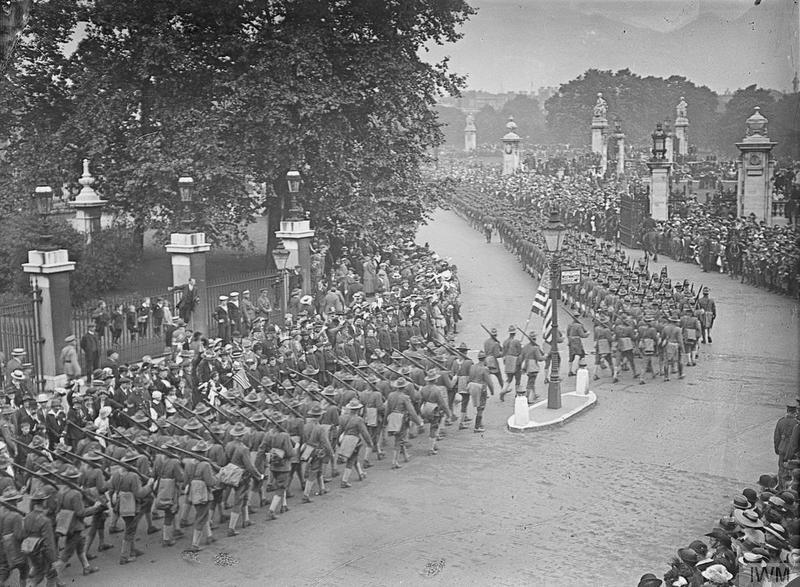
Formation of the AEF in World War I
- When the United States entered World War I in 1917, it only had a Regular Army of 127,000 soldiers. It became apparent that a well-organised and equipped military force was essential for success on the battlefield. As a result, the American Expeditionary Forces (AEF) was formed on 5 July 1917 under the command of Major General John Joseph 'Black Jack' Pershing. Initially, US President Woodrow Wilson planned to give command of the AEF to Gen. Frederick Funston. However, due to the latter's sudden death, Wilson appointed Pershing instead to lead the AEF.
- The AEF was a unique military force as it was the first time the United States had deployed a large-scale army overseas. This presented a myriad of challenges, including logistics, training, and coordination with Allied forces.
- One of the key aspects of the AEF's formation was its reliance on conscription. The Selective Service Act of 1917 allowed for the drafting of men into military service, resulting in an influx of troops for the AEF. This mass mobilisation enabled the AEF to grow rapidly and meet the demands of the war effort.
- African-Americans were also conscripted in WWI alongside whites and accounted for 13 percent of the draftees. Over 350,000 African-Americans served in AEF units on the Western Front by the war's end. However, they were placed into segregated units under the command of white officers.
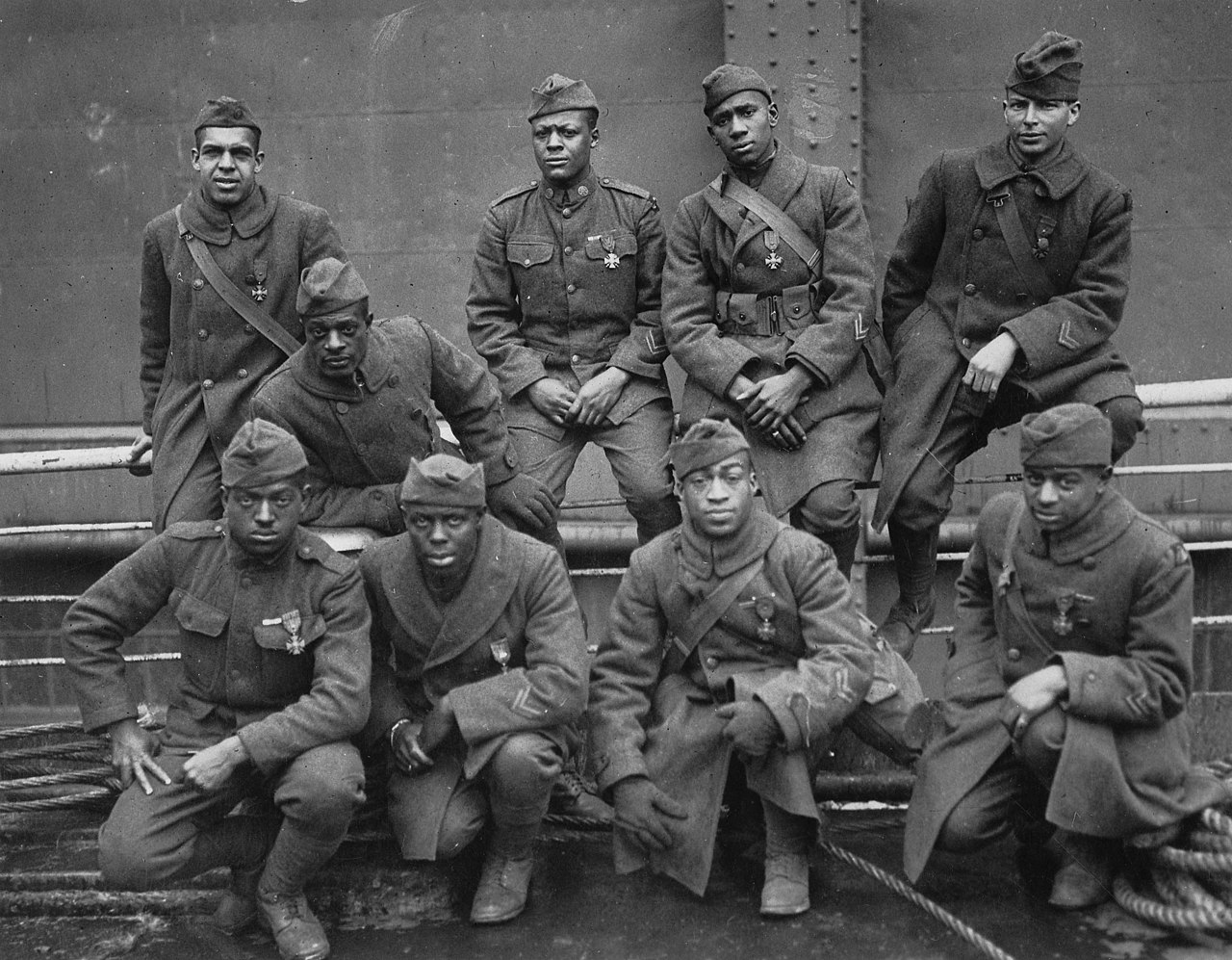
- Only one-fifth of the Black soldiers deployed to France engaged in combat compared to two-thirds of their white counterparts. They constituted 3 percent of AEF combat forces and comprised less than 2 percent of battlefield fatalities. In addition to this, they undertook unskilled labour roles such as stevedores at Atlantic ports and general labourers within camps and Rear Services in France.
- The AEF also focused on equipping its soldiers with the latest weaponry and technology. This meant coordinating the production and distribution of arms, ammunition and other supplies to ensure that the troops were well-prepared for the rigours of war.
- The AEF used French and British weaponry, with a special preference for the French canon de 75 modèle 1897, the canon de 155 C modèle 1917 Schneider, and the canon de 155mm GPF.
- Furthermore, American aviation units were equipped with SPAD XIII and Nieuport 28 fighters, while the US Army tank corps operated using French Renault FT light tanks. To facilitate training with these new weapons, Pershing set up facilities in France for newcomers to familiarise themselves with their equipment.
- The AEF's formation also involved the training and deployment of specialised units such as engineers, artillery and medical personnel. This comprehensive approach to military organisation allowed the AEF to function effectively on the battlefield and contribute significantly to the eventual Allied victory.
- As the AEF took shape, it also had to navigate the complexities of working alongside Allied forces from countries such as France and Britain. This involved adjusting to different tactics, languages and military cultures, further highlighting the need for effective leadership and coordination within the AEF.
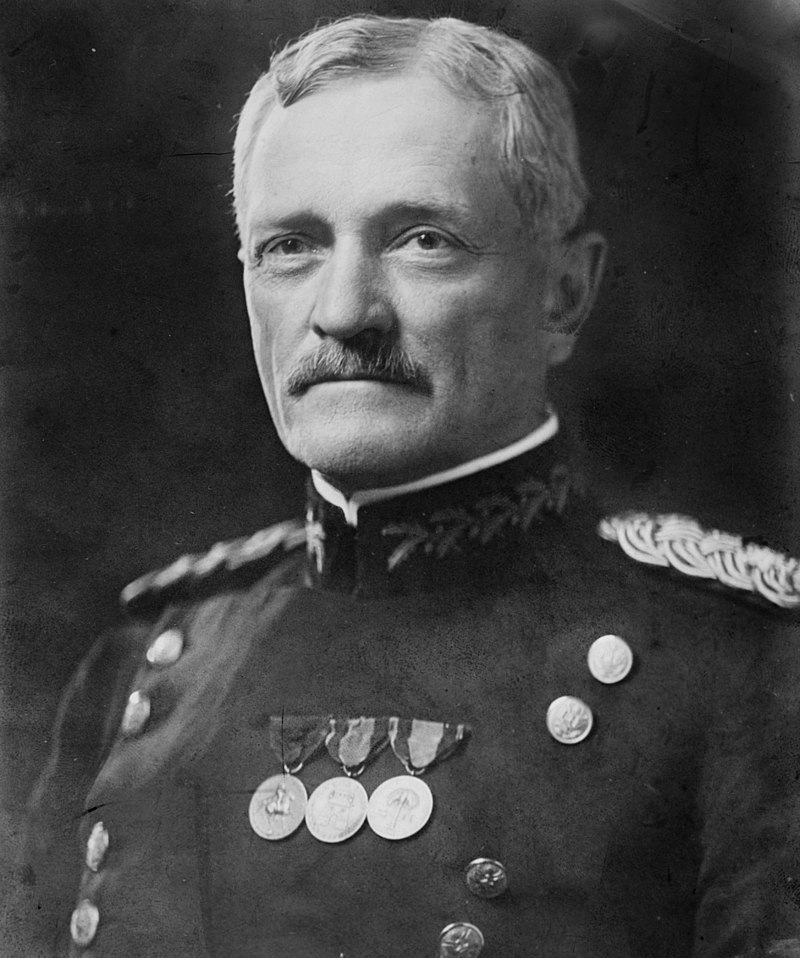
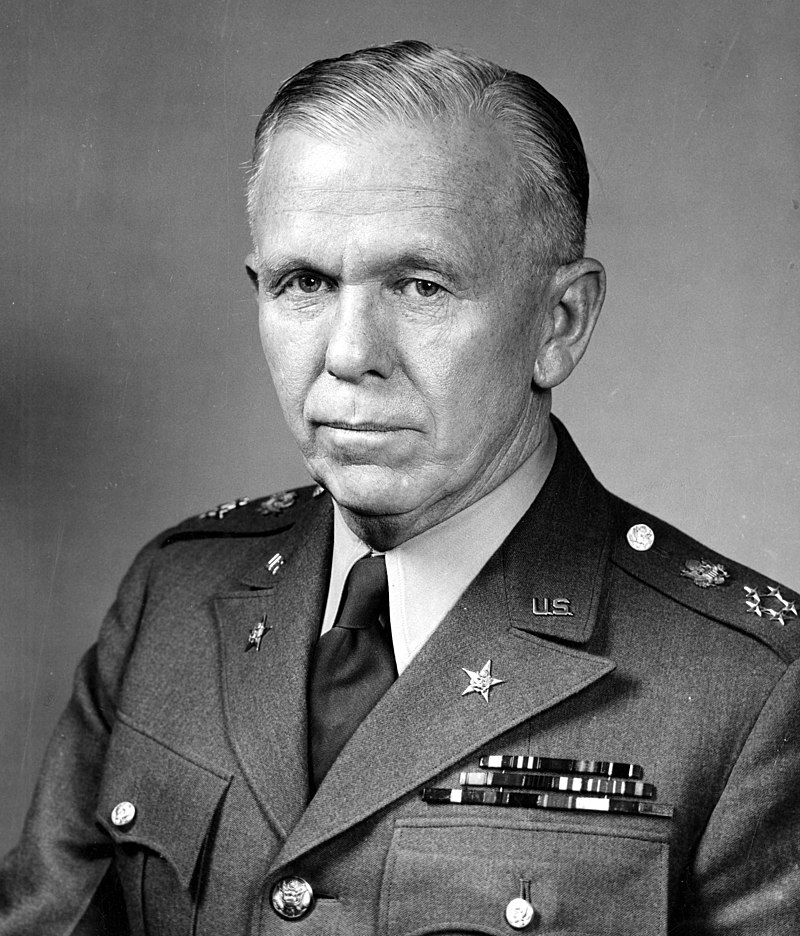
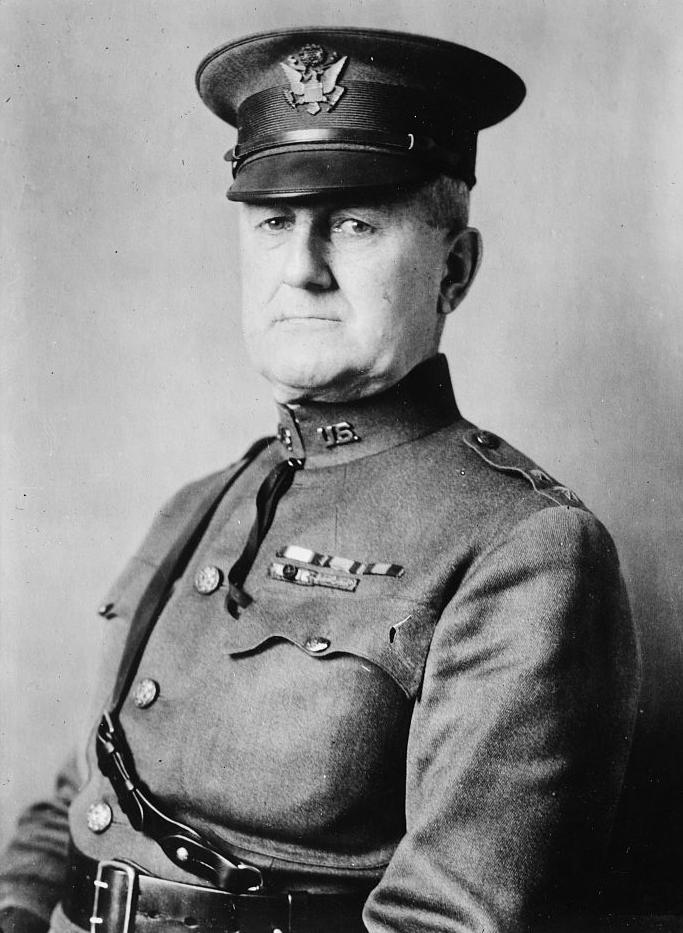
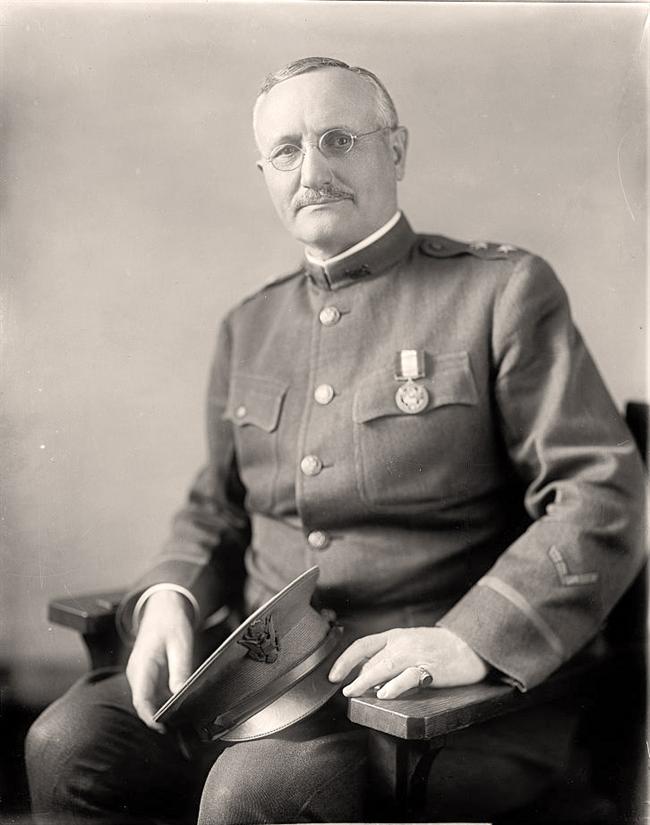
Key Figures and Leaders
- General John J Pershing played a pivotal role as the commander of the American Expeditionary Forces. His leadership and strategic vision were instrumental in shaping the AEF into a formidable fighting force. Known for his meticulous planning and insistence on rigorous training, Pershing's influence was evident in the AEF's operations and overall success on the battlefield.
- Another key figure within the AEF was General George C Marshall, who served as Pershing's chief of operations. Marshall's expertise in logistics and his ability to coordinate the complex movements of troops and supplies were essential to the AEF's effectiveness in combat. His leadership ensured that the AEF could sustain its operations and maintain a steady flow of resources to the frontline.
- Among the prominent leaders in the AEF was General James Harbord, who commanded the 4th Marine Brigade and later became the chief of staff to General Pershing. Harbord's leadership during the Battle of Belleau Wood and his contributions to the overall coordination of the AEF's forces solidified his influential role within the expeditionary forces.
- Furthermore, the AEF benefitted from the leadership of Major General William L Sibert, the commander of the 1st Division, who oversaw the deployment and operations of the AEF's engineer units. Sibert's expertise in engineering and his strategic planning were crucial in providing essential support for the AEF's infrastructure, fortifications and logistical capabilities.
- These key figures and leaders, among others, played vital roles in shaping the AEF's capabilities and ensuring its success in World War I. Their dedication to effective military organisation, strategic planning and coordination with allied forces was essential in facilitating the AEF's contributions to the eventual Allied victory.
Training and Deployment of American Troops Overseas
- The training and deployment of American troops overseas during World War I involved a concerted effort to prepare soldiers for the challenges of modern warfare and to effectively integrate them into the existing Allied forces. The scale and complexity of this undertaking required comprehensive planning, logistical coordination, and the adaptation of military tactics to the demands of trench warfare and open battlefield engagements.
- Training of American troops began in earnest following the United States' entry into the war. Camps and training facilities were established across the country to provide basic military instruction, physical conditioning and weapons proficiency to the rapidly expanding ranks of new recruits.
- Training also encompassed tactical manoeuvres, battlefield communication and cooperation with allied forces to ensure a cohesive and unified approach to combat operations.
- As the AEF prepared for deployment overseas, specialised training programmes were implemented to equip soldiers with the skills necessary for the realities of the Western Front. This included instruction in trench warfare tactics, gas mask usage, and navigating the challenging terrain of the battlefields. Furthermore, medical personnel underwent rigorous training to handle the unprecedented casualties and medical challenges brought about by the widespread use of new and devastating weaponry.
- American troops faced the daunting task of adjusting to the conditions and tactics of warfare in Europe, which differed significantly from those employed by the US military up to that point. The integration of American forces into the established command structure of the Allied armies required flexibility, adaptation and mutual understanding of each other's methods. This process involved joint training exercises, language instruction and the development of shared operational procedures to ensure effective cooperation on the battlefield.
- The deployment of American troops overseas was a monumental logistical feat, involving the transport of vast numbers of soldiers, equipment and supplies across the Atlantic Ocean. The logistical undertaking required the coordination of transport vessels, the establishment of supply depots in Europe, and the management of a continuous flow of reinforcements to sustain the AEF's operations.
- By June 1917, merely 14,000 American soldiers had reached France, and the AEF's contribution at the front was minimal until late October 1917. However, by May 1918, more than one million American troops were stationed in France, although only half of them saw action on the front lines. The first American soldiers to arrive in Europe were often referred to as 'Doughboys'.
- Due to a scarcity of transport ships for bringing American troops to Europe initially, the US Army used passenger liners and captured German ships while also borrowing Allied ships for transportation.
- Once on European soil, the AEF continued its training efforts, taking advantage of the expertise and experience of the Allied forces. American troops learnt from French and British units, assimilating lessons in trench warfare, artillery tactics and the use of combined arms in offensive operations. This exchange of knowledge and tactics contributed to the AEF's readiness for the intensity of combat on the Western Front.
Significant Battles and Contributions
Battle of Cantigny
- The American Expeditionary Forces made significant contributions to World War I through their involvement in several major battles that shaped the course of the war.
- One of the pivotal engagements was the Battle of Cantigny, which marked the first independent American offensive of the war. This successful operation not only boosted the morale of the Allied forces but also demonstrated the AEF's capability to lead and conduct offensive actions on the Western Front.
Battle of Belleau Wood
- Another crucial battle was the Battle of Belleau Wood, where the AEF faced intense German resistance in a densely forested area.
- Despite the difficult terrain and fierce enemy opposition, the AEF's resilience and determination led to a hard-fought victory. This triumph earned the AEF recognition for their combat prowess and solidified their reputation as a formidable fighting force.
Battle of Saint-Mihiel
- The AEF's involvement in the Battle of Saint-Mihiel showcased their ability to coordinate large-scale offensive operations. Under the leadership of General Pershing and his key commanders, the AEF successfully executed a coordinated attack, resulting in the liberation of the Saint-Mihiel salient.
- This decisive victory highlighted the AEF's strategic and operational acumen, contributing significantly to the overall momentum of the Allied advance.
Meuse-Argonne Offensive
- One of the most iconic battles in which the AEF played a crucial role was the Meuse-Argonne Offensive, the largest and bloodiest campaign in US military history.
- The AEF's relentless assault against well-entrenched German positions demonstrated their determination and combat effectiveness. Their relentless offensive eventually led to the collapse of the German line, hastening the end of the war and contributing to the overall Allied victory.
- The AEF's contributions extended beyond direct combat engagements. Their logistical expertise and support capabilities were vital in sustaining the Allied war effort. The AEF effectively managed the transportation of troops, supplies and equipment, ensuring a continuous flow of resources to the frontline. Their efficient logistical operations played a critical role in maintaining the momentum of the Allied offensives and ultimately contributed to the defeat of the Central Powers.
Challenges Faced
- The American Expeditionary Force faced numerous challenges during its involvement in World War I, presenting formidable obstacles that demanded innovative solutions and adaptability. One of the primary challenges was the sheer scale of mobilising and deploying a large military force across the Atlantic Ocean. This logistical feat required extensive coordination of transport vessels, provision of supplies and management of the continuous influx of troops.
- Logistics operations during World War I were overseen by Charles G Dawes, a Chicago banker who held the rank of colonel and later brigadier general. Reporting directly to Gen. Pershing, Dawes proposed in May 1918 that the Allies establish a joint logistics planning board, leading to the creation of the Military Board of Allied Supply. This coordination effort managed logistics and transportation on both the Western and Italian fronts.
- The Services of Supply played a crucial role as the support chain for the AEF in various countries like France, England, Italy and the Netherlands under its designation 'Line of Communications'. It introduced innovative support techniques such as forward maintenance, field cooking, graves registration, host nation support services, motor transport and morale-boosting activities. The work conducted by logisticians was instrumental in ensuring AEF's success while also contributing significantly to establishing the American Army as an effective modern fighting force.
- The unfamiliarity with the battleground terrain and the tactics employed in European warfare also presented significant hurdles for the American troops. Trench warfare, in particular, was a new and daunting concept for many soldiers, necessitating comprehensive training and adaptation to effectively navigate and engage in this style of combat.
- Understanding and integrating with the established command structure of the Allied armies also posed a challenge, as it required agile coordination and a harmonious blend of military methods and practices.
- The AEF encountered logistical challenges in sustaining their operations on the Western Front. Supply lines had to be efficiently managed to ensure a steady provision of ammunition, rations and medical resources amid the demanding and often volatile conditions of the battlefield. The coordination of these critical supplies under the pressures of combat posed a constant challenge for the AEF.
- Moreover, the AEF had to contend with the medical complexities brought about by the widespread use of new and devastating weaponry. Treating casualties resulting from gas attacks, high-explosive shelling and machine gun fire required an evolved approach to medical care.
- The introduction of new medical practices and the management of mass casualties demanded innovative solutions to address the unprecedented challenges faced by the medical units of the AEF.
- The AEF's communication infrastructure also posed challenges as effective battlefield communication was essential for coordinated operations.
- Overcoming language barriers, establishing reliable communication lines, and adapting to the dynamics of communication in a fast-changing and chaotic environment were critical challenges that the AEF continually worked to address.
- In addition, the AEF struggled with the challenge of adapting to the severe and unrelenting conditions of warfare in Europe. Enduring the physical and psychological strains of prolonged warfare, navigating the treacherous terrains of the battlefields, and contending with the ever-present threat of enemy engagement demanded unwavering resilience from the American troops.
- Successfully surmounting these challenges required a combination of strategic planning, flexible adaptation and unwavering determination from the leadership, soldiers and support personnel of the American Expeditionary Force.
Impact of the AEF on the Outcome of World War I
- The contributions of the American Expeditionary Forces played a crucial role in shaping the outcome of World War I. By the time the AEF began to engage in significant combat operations, the war had reached a critical juncture. The introduction of fresh and substantial American forces into the conflict had a profound impact on the overall momentum of the Allied advance, ultimately tilting the balance in favour of the Allies.
- The Battle of Cantigny, the first independent American offensive, not only demonstrated the combat capability of the AEF but also signalled a shift in the dynamics of the war. The successful operation boosted the morale of the Allied forces and marked the beginning of a series of decisive engagements that would significantly impact the outcome of the war.
- Subsequent battles, such as the Battle of Belleau Wood, the Battle of Saint-Mihiel and the Meuse-Argonne Offensive, further underscored the AEF's instrumental role in shifting the tide of the war. The AEF's determination, combat effectiveness and strategic acumen in these crucial battles directly contributed to the erosion of German defences and the eventual collapse of the Central Powers.
- The relentless offensive of the AEF during the Meuse-Argonne Offensive, in particular, inflicted significant losses on the German army and hastened the deterioration of their military capabilities. The collapse of the German line under the pressure of the AEF's assault directly contributed to the hastening of the end of the war and the eventual victory of the Allies.
- Furthermore, the logistical expertise and support capabilities of the AEF were indispensable in sustaining the Allied war effort. The efficient management of troop transportation, supply lines and equipment logistics by the AEF played a pivotal role in maintaining the momentum of the Allied offensives, providing crucial support for the frontline operations, and ultimately contributing to the defeat of the Central Powers.
- By the time Germany agreed to the Armistice on 11 November 1918, the American Expeditionary Forces had become a well-respected and battle-proven military, considered one of the best in the world.
- The AEF experienced approximately 320,000 casualties, including 53,402 deaths in battle, 63,114 non combat-related deaths and 204,000 wounded. Only a small proportion of soldiers actually sustained physical harm from poison gas. However, many more believed they had been exposed to it erroneously. Additionally, during the autumn of 1918, over 25,000 AEF personnel succumbed to the influenza pandemic while around 360,000 fell seriously ill.
Image Sources
- https://upload.wikimedia.org/wikipedia/commons/6/6e/The_US_Army_in_Britain%2C_1917-1918_Q30005.jpg
- https://upload.wikimedia.org/wikipedia/commons/thumb/5/5c/369th_15th_New_York.jpg/1280px-369th_15th_New_York.jpg
- https://upload.wikimedia.org/wikipedia/commons/thumb/e/e9/General_John_Joseph_Pershing_head_on_shoulders.jpg/800px-General_John_Joseph_Pershing_head_on_shoulders.jpg
- https://upload.wikimedia.org/wikipedia/commons/thumb/e/e6/George_Catlett_Marshall%2C_general_of_the_US_army.jpg/800px-George_Catlett_Marshall%2C_general_of_the_US_army.jpg
- https://upload.wikimedia.org/wikipedia/commons/e/e7/James_Harbord.jpg
- https://upload.wikimedia.org/wikipedia/commons/7/77/William_L._Sibert.jpg
Frequently Asked Questions
- What was the American Expeditionary Force (AEF)?
The AEF was the United States Army's contribution to the Allied forces during World War I. It comprised American troops sent to Europe to fight alongside the Allies.
- Why did the United States join World War I, and what role did the AEF play?
The United States entered World War I in April 1917 in response to unrestricted submarine warfare by Germany. The AEF played a crucial role in turning the tide of the war in favour of the Allies.
- When was the AEF established?
The AEF was officially established on 26 June 1917 under the command of General John J. Pershing.
